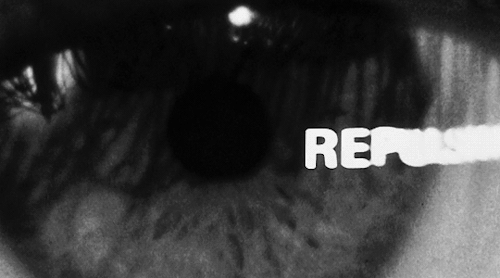Repulsion (1965)
Fig.1
Repulsion (1965) is a surrealist horror film based on the sexual anxiety faced by a young Belgium woman named Carol who lives in Kensington London with her older sister Helen and works as a manicurist. This film was directed by the superb Roman Polanski, and is a film where he was clearly pushing the boundaries of what was acceptable to show in cinema in the early days of conveying some rather controversial scene's., in a time of which sexual freedom was at an all time high. "...Represents a unique place in the filmography of Roman Polanski...but in the 1965 it plays as an antidote to the prevailing attitude of exuberant sexual freedom, a horror film of sorts for the swinging 60's." (Bacchus, 2009).
The main plot revolves around a complex mental state that Carol seems to have developed where she seem's to be literally Repulsed by men, even to the point where it appears she is going be physically sick after an encounter with a young man. At first this doesn't seem to be a big problem in Carol's life style, considering she works in a salon that appears to be manned by an entirely female staff, lives with her sister, and besides a few chance encounters with random individuals while travelling between destinations, rarely ever comes in contact with any men at all.
That is, she heads home and we find out that her sister is in a relationship with an adulterous man who is currently married to another women (not helping her already established disgust of men) and after a scene where she actively avoids seeing him shave, and that night hears the couple's pleasured moans through the walls, we find out that they are going away to Italy together for a short while, leaving Carol in the apartment, on her own.
For the duration of this time alone, we bare witness as Carol goes through a mental breakdown. As she is exposed to a young man who has taken interest in her, and proceed's to pursue her romantically to her dis-appeal. Which proceed's to bring on to her a level of anxiety, which slowly develops to such a state over this time, to where she appears to hallucinate an encounter each night with a random man, who appears to manifest in her apartment each night while she sleeps, and then proceeds to sexually assault/rape her.
This proceed's to escalate as Carol's mental state rapidly declines, for the most part you are actually left to question whether these encounters are actually happening or not, there appears to be no physical way for it to be possible, but the end results and what we are shown seems to strongly imply this is happening, yet we are left with no possible evidence to the man being real or actually entering the building. "Our first hint that we have entered a new world is when, along with her, we catch a glimpse of a man's figure in the mirror......Soon after, we are thrust into her (literal) dream and nightmares. And things grow increasingly worse from there, until the viewers struggle to tell whether what is happening to her is real or imaginary." (Smalley, 2011).
As her sanity shatters, we begin to witness progressively surreal sights taking place in the apartment, the most note worthy and iconic though. This being the scene's where we are shown her apartment morphing and changing around her. We are shown a hallway, which then grows multiple arms which from the walls, becoming a forest of non consensual touching, which proceed to grope her as she walks through. This shows her near constant worry of her own safety and purity, as she can no longer even feel safe in her home.
Fig.3
But to really seal the deal, a shot of the walls of her apparent growing large cracks and chasms through them, which appears to imply in a literal metaphor of her mental state literally breaking. The apartment at this point representing her own mind and the cracks representing her insanity and anxiety. A safe place becoming corrupted and wrong. "The Screenplay by Polanski and Gerard Brach is a model of intelligence, subtlety and the power of suggestion and understatement....it's a polished, startling-looking film thanks to Gilbert Taylor's fine, imaginative cinematography." (Winnert, 2013).
Her madness eventually escalates to a level to where she murder's the man who is infatuated with her, who follows her home, forces her way into her apartment, and after confessing her feelings is killed by Carol with a hit to the head, hiding his body in the bathroom. The film concludes with the landlord finding the apartment in shambles, and after attempting to reassure Carol, he forces himself on to her and attempts to initiate intercourse, only for Carol to slash him to death with her sisters boyfriends razor blade from the beginning of the film (deus ex razor blade?)
Eventually her family and other apartment building residents discover the scene and escort Carol out the building, unaware the source of the slaughter was her. We are left with an ominous ending where we are shown a picture of Carols family in her youth, where she is seen scowling at her father, possibly implying some sort of incident or horrifying relationship may have occurred, which left her as she is now.
Bibliography:
Bacchus, At : http://www.dailyfilmdose.com/2009/08/repulsion.html
Smalley, G : http://366weirdmovies.com/repulsion-1965/
Winnert, D : http://derekwinnert.com/repulsion-classic-film-review-66/
List Of Illustrations:
Fig.1 : http://barbara-stanwyck.tumblr.com/post/133617280418/repulsion-1965
Fig.2 http://ianhendry.com/repulsion-1965/repulsion-1965-posters/
Fig.3 http://www.silenzio-in-sala.com/immagini_repulsione.html






Interesting review Bard :)
ReplyDeleteJust remember that the quotes should be in italics, and not the reference after them... and you also need some other information in the bibliography - see here http://community.ucreative.ac.uk/Harvard-Referencing
Also be careful where you are putting apostrophes - you have used them in several instances where they are not needed - 'seem's' and 'proceed's' for example.